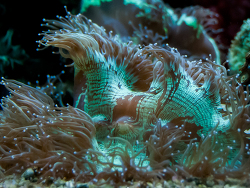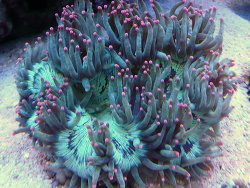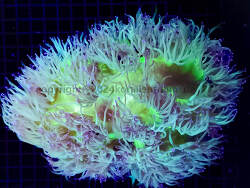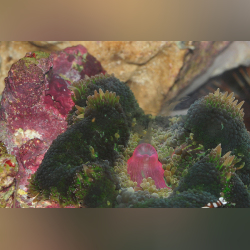Info
Description: Colonies are flabello-meandroid with straight edged septa forming wide V-shaped valleys. Valleys are evenly spaced and have sharp edged walls. Septa are widely spaced. There are no columellae. Polyps have large tubular tentacles extending from large fleshy oral discs. Forms satellite colonies (like the poritid Goniopora stokesi) in aquaria.
Color: Distinctive green with pink tentacle tips and a striped oral disc.
Abundance: Seldom common but conspicuous. Rare in the western Indian Ocean.
Similar Species: Flabello-meandroid Euphyllia are similar but have septa which steeply plunge at the valley centre and do not form V-shaped valleys.
Synonyms:
Catalaphyllia plicata sensu Wells (1971)
Euphyllia picteti Bedot, 1907
Euphyllia picteti var. flexuosa Bedot, 1907
Flabellum multifore Gardiner, 1904
Flabellum vacuum Crossland, 1952
Pectinia jardinei Saville Kent, 1893
Classification: Biota > Animalia (Kingdom) > Cnidaria (Phylum) > Anthozoa (Class) > Hexacorallia (Subclass) > Scleractinia (Order) > Euphylliidae (Family) > Catalaphyllia (Genus) > Catalaphyllia jardinei (Species)







 Klaus43
Klaus43























